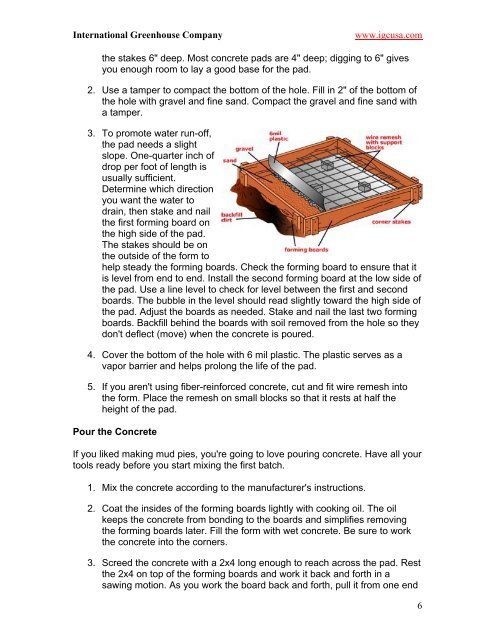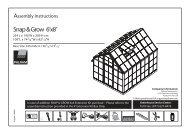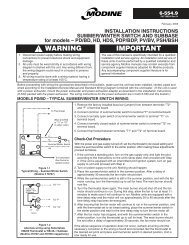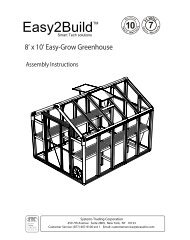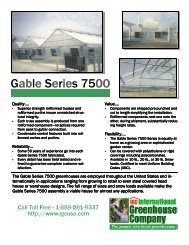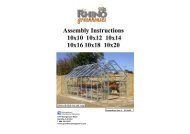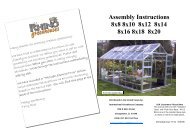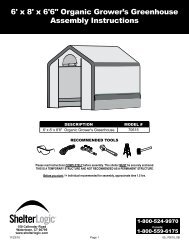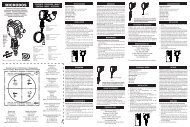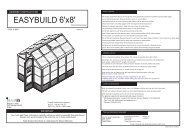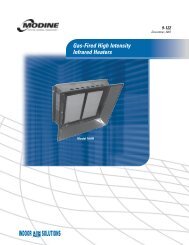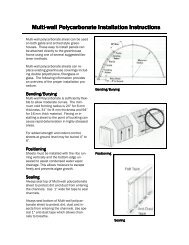International Greenhouse Company www.igcusa.com 1 Greenhouse ...
International Greenhouse Company www.igcusa.com 1 Greenhouse ...
International Greenhouse Company www.igcusa.com 1 Greenhouse ...
Create successful ePaper yourself
Turn your PDF publications into a flip-book with our unique Google optimized e-Paper software.
<strong>International</strong> <strong>Greenhouse</strong> <strong>Company</strong><br />
<strong>www</strong>.<strong>igcusa</strong>.<strong>com</strong><br />
the stakes 6" deep. Most concrete pads are 4" deep; digging to 6" gives<br />
you enough room to lay a good base for the pad.<br />
2. Use a tamper to <strong>com</strong>pact the bottom of the hole. Fill in 2" of the bottom of<br />
the hole with gravel and fine sand. Compact the gravel and fine sand with<br />
a tamper.<br />
3. To promote water run-off,<br />
the pad needs a slight<br />
slope. One-quarter inch of<br />
drop per foot of length is<br />
usually sufficient.<br />
Determine which direction<br />
you want the water to<br />
drain, then stake and nail<br />
the first forming board on<br />
the high side of the pad.<br />
The stakes should be on<br />
the outside of the form to<br />
help steady the forming boards. Check the forming board to ensure that it<br />
is level from end to end. Install the second forming board at the low side of<br />
the pad. Use a line level to check for level between the first and second<br />
boards. The bubble in the level should read slightly toward the high side of<br />
the pad. Adjust the boards as needed. Stake and nail the last two forming<br />
boards. Backfill behind the boards with soil removed from the hole so they<br />
don't deflect (move) when the concrete is poured.<br />
4. Cover the bottom of the hole with 6 mil plastic. The plastic serves as a<br />
vapor barrier and helps prolong the life of the pad.<br />
5. If you aren't using fiber-reinforced concrete, cut and fit wire remesh into<br />
the form. Place the remesh on small blocks so that it rests at half the<br />
height of the pad.<br />
Pour the Concrete<br />
If you liked making mud pies, you're going to love pouring concrete. Have all your<br />
tools ready before you start mixing the first batch.<br />
1. Mix the concrete according to the manufacturer's instructions.<br />
2. Coat the insides of the forming boards lightly with cooking oil. The oil<br />
keeps the concrete from bonding to the boards and simplifies removing<br />
the forming boards later. Fill the form with wet concrete. Be sure to work<br />
the concrete into the corners.<br />
3. Screed the concrete with a 2x4 long enough to reach across the pad. Rest<br />
the 2x4 on top of the forming boards and work it back and forth in a<br />
sawing motion. As you work the board back and forth, pull it from one end<br />
6


